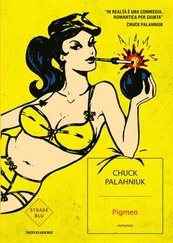Chuck Palahniuk - Fugatives & Refugees
Здесь есть возможность читать онлайн «Chuck Palahniuk - Fugatives & Refugees» весь текст электронной книги совершенно бесплатно (целиком полную версию без сокращений). В некоторых случаях можно слушать аудио, скачать через торрент в формате fb2 и присутствует краткое содержание. Жанр: Современная проза, на английском языке. Описание произведения, (предисловие) а так же отзывы посетителей доступны на портале библиотеки ЛибКат.
- Название:Fugatives & Refugees
- Автор:
- Жанр:
- Год:неизвестен
- ISBN:нет данных
- Рейтинг книги:5 / 5. Голосов: 1
-
Избранное:Добавить в избранное
- Отзывы:
-
Ваша оценка:
- 100
- 1
- 2
- 3
- 4
- 5
Fugatives & Refugees: краткое содержание, описание и аннотация
Предлагаем к чтению аннотацию, описание, краткое содержание или предисловие (зависит от того, что написал сам автор книги «Fugatives & Refugees»). Если вы не нашли необходимую информацию о книге — напишите в комментариях, мы постараемся отыскать её.
Fugatives & Refugees — читать онлайн бесплатно полную книгу (весь текст) целиком
Ниже представлен текст книги, разбитый по страницам. Система сохранения места последней прочитанной страницы, позволяет с удобством читать онлайн бесплатно книгу «Fugatives & Refugees», без необходимости каждый раз заново искать на чём Вы остановились. Поставьте закладку, и сможете в любой момент перейти на страницу, на которой закончили чтение.
Интервал:
Закладка:
"I don't know why," Jeb says, "but they gave Chendra my birthday, February 20, so she's a Pisces."
About Hugo, Jeb Barsh says, "He's the 'Anti-Packy.' Some people call him 'Hugo the Horrible,' but he's my favorite bull. He's got such an energy field when you're with him. He's like a hot rock!" Jeb says, "He is the truth! He's energy personified! He's a hot daddy! He's a ride in a fast car!"
Hugo was captured in Thailand at about age four, and came to Portland via another zoo and a circus. "Everything I could say about Packy," Jeb says, "you could say the opposite about Hugo."
Hugo has a straight tail. Packy and all his descendants have a genetic trait for crooked tails. As a young elephant the tip of Hugo's trunk—equivalent to a human's thumb— was bitten off, so he's a little clumsy at grabbing items.
Jeb, Tom, Bob, and Steve explain how elephants walk on just the tip of their toes, protecting the sensitive pad in the center of their feet. They can stop a rolling apple without bruising it. Their trunks have forty thousand muscles, and can weigh five hundred pounds and hold five gallons of water. Each elephant has only four teeth, all of them huge. They go through six sets of these teeth and typically die of starvation after wearing out the last set. Up to 80 percent of their communication is via "infrasound," subaudible sounds that for years led people to think elephants had ESP and could read each other's minds.
"An elephant's brain is four and a half times bigger than mine," Jeb says. "It's fifty percent more convoluted, so they're incredible problem solvers." He explains, "The elephant's brain has all these pathways for storing memory. As herbivores they don't need to be 'wily.'" One reason why elephants carry so much memory is because they're so destructive to their environment that they need to constantly know where to find more food.
"They're touchingly similar to human beings," Jeb says. "They show a great deal of affection for each other. They're curious. They stay together as a family unit and won't abandon an elderly member. They even seem to mourn the death of each other."
Asian elephants have been crowded out of their habitat for centuries, and now only forty thousand are left in the world. As a pragmatist, Jeb Barsh talks about Charles Darwin's idea that extinction is a natural, acceptable event. And maybe there is no more place for these huge, charismatic animals that require so many resources to live.
About the Portland zoo, Jeb says, "This isn't Utopia, but for them there is no Utopia left."
At THE Zoo
If you want to see animals and not people, go to the zoo early and come in the cool spring or fall. According to Krista Swan, event coordinator for the Oregon Zoo, most of the animals are "corpuscular," meaning they're most active at dawn or dusk. Before the zoo opens at nine, the keepers hold the animals backstage while they clean each exhibit. At nine the animals are released into their fresh habitats and are most likely to be active and awake.
Knights Boulevard, in front of the Oregon Zoo, is named for Dr. Richard Knight, a former sailor who ran a drugstore on SW Morrison Street near Third Avenue. For sailing ships a pet was an important mascot, usually a monkey or a parrot. Sailors would leave their pets with Knight and never return for them. In 1885, Knight fenced the vacant lot next to his store, bought a grizzly bear for $75 and a cinnamon bear for $50, named them Brown and Grace, and started a zoo. In 1887 he donated his menagerie to the city, but he still had to feed and clean the animals, which were kept in the cages of a failed traveling circus, on forty acres the city set aside as City Park. By 1893 the park inventory included "3 wheelbarrows, 1 auger (bad order), 1 pump, 6 deer, 5 axes, 1 grindstone, 2 padlocks, 1 force pump, 1 grizzly bear, 300 flower pots, 1 seal."
Unless you want to see crowds of irritable people, do not come to the zoo in the hot summer months. Do not drive your car. Parking is limited and people will circle forever before they park, then buy a ticket and walk through the gate very cranky. Instead, take the westside MAX train. Park downtown, or park in the western suburb park-and-ride lots (in Beaverton or Hillsboro) along the MAX line. Get off at the zoo stop and ride the elevator up. For another good train ride, park at the Washington Park Rose Garden and walk to the hillside zoo train station. You can avoid the crowd and buy your ticket here, then ride the miniature Wild West steam train or the streamlined retro-aluminum Zoo Liner through the forest and into the center of the zoo.
If you can't handle the morning, bring a picnic lunch and a blanket and come for a concert in the evening. After April 1 check out www.oregonzoo.org for each summer season of twenty-five concerts, including artists like Ray Charles, the Cowboy Junkies, and Los Lobos.
Here are some animals you absolutely must meet.
The Penguins: Look for Mochika, a Humbolt penguin who refuses to mate or build a nest despite the keepers' best efforts. Instead, he hangs out in the keepers' kitchen. The keepers wonder if it's because he has a feminine name, but instead of another penguin—male or female—Mochika loves men's black boots. "I mean he really likes boots," Krista says. "In the biblical sense, he knows boots. You can feed him a fish, but you always have to watch out for your shoes."
The Sea Otters: Look for Thelma and Eddy. Like all southern sea otters from the Monterey Bay Aquarium in California, they're named for characters in John Steinbeck novels. They live on an annual $25,000 diet of fresh mussels, clams, crab, and other shellfish. When they were placed in the new exhibit, keepers thought they were too young to mate. "Then Thelma turned up pregnant," says Krista. Thelma's pup is the first southern sea otter pup to be born and survive in captivity. Now zoos are hounding Portland. "It's a little embarrassing. They keep asking us what we did differently," Krista says. "The truth is, we don't know. We did it without even trying."
The Black Rhinos: Pete and Miadi have been reintro-duced to each other after having a baby several years ago. Since then, Miadi flirts: She bumps and rubs against Pete, trying to make him "flamen" and smell her pheromones. "It's when animals, cats included, kind of lift their upper lip and sniff hard," Krista says. It's not until Miadi urinates in his face that Pete chases her. After that, Miadi plays coy and hard to get until Pete gives up. "It's like Miadi's saying, 'You're not going to pay any attention to me? Well, smell my pee!'" Krista says and laughs. "See," she says, still pretending to be Miadi, "I knew you wanted some."
The Monkeys: In the Amazon Flooded Forest, look for J.P., a female howler monkey that jumps on everyone's head the moment they enter the exhibit. Keepers or volunteers, no one knows why, but J.P. has to sit on everyone's head.
Also look for Sweet Tillie, a baby swamp monkey. "She seems to enjoy causing as much trouble as possible," Krista says. Especially when she swings from the tail of the rival colobus monkeys and expects her father to defend her.
And don't miss Charlie the chimpanzee. "Charlies kind of famous for playing games with the people he likes," Krista says, "and throwing fecal matter at the people he doesn't." He knows a little sign language, and if he likes you, he'll introduce himself. He points at himself and signs the letter C with one hand against his chest. If Charlie points to the door that separates his inside and outside areas, he's challenging you to a race. Go ahead and run, but if you run and beat him to the next area, he screams and thrashes with rage.
The Wolves: Look for Marcus, an almost completely black male wolf. But please, Krista says, don't call him by name and do not howl. "People go to the exhibit and howl," she says, "and it's really disruptive. This is how wolves communicate. People have no idea what they're saying."
Читать дальшеИнтервал:
Закладка:
Похожие книги на «Fugatives & Refugees»
Представляем Вашему вниманию похожие книги на «Fugatives & Refugees» списком для выбора. Мы отобрали схожую по названию и смыслу литературу в надежде предоставить читателям больше вариантов отыскать новые, интересные, ещё непрочитанные произведения.
Обсуждение, отзывы о книге «Fugatives & Refugees» и просто собственные мнения читателей. Оставьте ваши комментарии, напишите, что Вы думаете о произведении, его смысле или главных героях. Укажите что конкретно понравилось, а что нет, и почему Вы так считаете.




